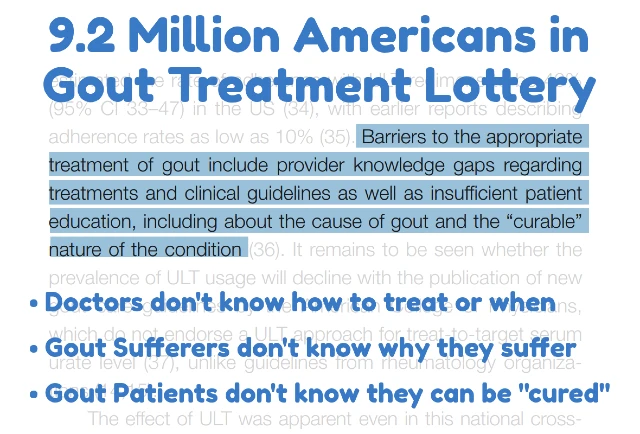The big picture about gout emerges from surveying thousands of people over many years. Because we can see how prevalent gout is. Also, we can assess how many people get treated. Then how successful that treatment is.
So if you’re one of the millions of gout sufferers. What’s your chance of gout recovery?
Citation for Gout Treatment Lottery
This is a GoutPal review of:
Chen‐Xu, Michael, Chio Yokose, Sharan K. Rai, Michael H. Pillinger, and Hyon K. Choi. “Contemporary prevalence of gout and hyperuricemia in the United States and decadal trends: the national health and nutrition examination survey, 2007–2016.” Arthritis & Rheumatology 71, no. 6 (2019): 991-999.
At the time of writing, this study has been cited by 37 other studies.
Gout Treatment Lottery Purpose
Using surveys of American men and women from 2007 to 2016, the study aims to estimate:
- Rates of gout and high uric acid.
- 10-year trends in those rates.
- Rates of uric acid treatment in gout patients.
Jargon-free Abstract
In the jargon-free abstract I present the key points of the original abstract. Replacing jargon with terms more familiar to unqualified people interested in gout. Note that my selection of jargon terms might not match yours. So please leave a note in the feedback form near the end of the page if you need clarification.
- Methods
- For 2015-16, the study:
- Used data from 5,467 people to find rates of gout and high uric acid.
- Uric acid was classed as high when greater than 7.0 mg/dl in men and 5.7 mg/dl in women.
- Goes back to 2007 to look at 10 year gout trends up to 2016.
- Also looks at uric acid treatment trends up to 2014.
- Results / Findings
- In 2015–2016:
- Gout affected just under 4 of every 100 American adults.
- Of the 9+ million adults, almost 6 million are men. With over 3 million women.
- Average blood uric acid levels were 6.0 mg/dl in men and 4.8 mg/dl in women.
- Rates remained stable between 2007 and 2016.
- One-third of gout patients were given uric acid treatment.
Original Abstract
Objective. To estimate the current prevalence rates and decadal trends of gout and hyperuricemia in the US, as well as the prevalence of urate-lowering therapy (ULT) among gout patients, using 2007–2016 data from a nationally representative survey of American men and women (the National Health and Nutrition Examination Survey [NHANES]).
Methods. Using data from 5,467 participants in the NHANES 2015–2016, we estimated the most recent prevalence rates of gout and hyperuricemia. When the NHANES was conducted, all participants were asked about their history of gout (as diagnosed by a health professional) and medication use. Hyperuricemia was defined as having a serum urate level of >7.0 mg/dl in men and >5.7 mg/dl in women. We examined decadal trends in these estimates using data from the NHANES 2007–2016 and investigated ULT usage trends using the NHANES 2007–14 (the most recent data available to date).
Results. In 2015–2016, the prevalence of gout was 3.9% among adults in the US (9.2 million people), with 5.2% [5.9 million] in men and 2.7% [3.3 million] in women. Mean serum urate levels were 6.0 mg/dl in men and 4.8 mg/dl in women, and hyperuricemia prevalence rates were 20.2% and 20.0%, respectively. The prevalence rates of gout and hyperuricemia remained stable between 2007 and 2016 (P for trend > 0.05). The prevalence of ULT use among patients with gout was 33% in 2007–2014 and remained stable over time (P for trend > 0.05).
Conclusion. In this nationally representative survey sample of adults in the US, the prevalence rates of gout and hyperuricemia remained substantial, albeit unchanged, between 2007 and 2016. Despite these rates, only one-third of gout patients were receiving ULT.
Gout Treatment Lottery Conclusions
The rate of gout suffering from 2007 through 2016 remains substantial.
findings using a nationally representative sample of adults in the US indicate that the prevalence rates of gout and hyperuricemia remain substantial
Around one-third of gout patients get uric aid treatment. And just over one-third have uric acid below 6 mg/dL.
approximately one-third of gout patients are receiving ULT and just over one-third of gout patients have a serum urate concentration at the rheumatology guideline target level for disease control
Risk factor for failing to achieve target uric acid levels are: male gender; obesity; chronic kidney disease; and certain water pills.
In the general population, male sex, obesity, CKD, and thiazide diuretic use were risk factors for failing to reach a therapeutic target serum urate level, suggesting the potential need for a more aggressive approach within these groups

Cited By
- Reset the Dialogue on Gout Lies
- Horizon’s Gout Lies campaign aims to change the way doctors talk about gout. You can learn a new language of gout. Then talk to your doctor about gout recovery.
Subscribe to Free GoutPal Links
Subscription is free, and your email address is safe - I will never share it with anyone else. I use Gumroad to provide this service, as described at GoutPal Links Newsletter Service.
Leave Gout Treatment Lottery to read Gout Library Home Page.
Gout Treatment Lottery Vocabulary
-
hyperuricemia
high uric acid
-
serum
liquid part of the blood
-
thiazide diuretic
water pill – a type of drug that encourages passing urine.
-
ULT (Urate Lowering Therapy)
uric acid treatment